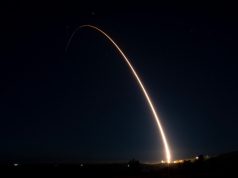The US Strategic Command (USSTRATCOM) tested its ability to conduct coordinated, global strategic deterrence with the conclusion of a series of operational events and test launches of the nuclear triad this month.
USSTRATCOM coordinated these strategic opportunities with combatant commands and components across multiple geographic areas to exercise each leg of the nuclear triad – long-range bombers, intercontinental ballistic missiles (ICBMs), and submarine-launched ballistic missiles (SLBMs).
“Our nuclear deterrent underwrites every U.S. military operation around the world and is the backstop and foundation of our national defense,” said Adm. Charles Richard, USSTRATCOM commander. “These tests and operations validate the reliability, accuracy and performance of the nuclear triad and ensure I can provide the President with a range of flexible deterrent options.”
The coordinated events were conducted from Feb. 3-12, and included a Bomber Task Force (BTF) flight of B-52 Stratofortress long-range bombers and test launches of an unarmed ICBM and SLBM.
Air – Bomber Mission
On Feb. 3, a US Air Force B-52H Stratofortress bomber from Minot Air Force Base, North Dakota, rendezvoused with a B-52H from Anderson Air Force Base, Guam, in the vicinity of Misawa Air Base, Japan, as part of a combined BTF and Continuous Bomber Presence mission.
The two bombers also conducted bilateral joint training with 13 Japan Air Self Defense Force (JASDF) F-2s, four F-4s, and 28 F-15s, and six US Air Force F-16s in the vicinity of Japan before returning to Andersen.
USSTRATCOM has conducted regular BTF missions since 2014 to integrate and synchronize with Geographic Combatant Command’s operations and capabilities, and demonstrate the U.S. commitment to deterrence, assurance, and collective security.
Strategic bomber missions enhance the readiness and training necessary to respond to any potential crisis or challenge across the globe.
Land – ICBM Test
Air Force Global Strike Command (AFGSC) Airmen from the 341st Missile Wing at Malmstrom Air Force Base, Montana, the 90th Missile Wing at F.E. Warren Air Force Base, Wyoming, and the 91st Missile Wing at Minot Air Force Base, North Dakota, launched an unarmed Minuteman Ill ICBM equipped with a test reentry vehicle on February 5, from Vandenberg Air Force Base, California.
The ICBM’s reentry vehicle traveled approximately 4,200 miles to the Kwajalein Atoll in the Marshall Islands. This test was a developmental test launch, which used a spare missile from storage to validate flight worthiness of new or replacement components in an as-near-to operational environment as possible.
Sea – Submarine Ballistic Missile Test
The US Navy conducted a test flight of a single unarmed life-extended Trident II (DSLE) missile from USS Maine (SSBN-741), an Ohio-class ballistic missile submarine, on the Western Test Range off the coast of San Diego, California, February 12.
The test was part of a demonstration and shakedown operation, designated DAS0-30. The primary objective of a DASO is to evaluate and demonstrate the readiness of the SSBN’s strategic weapon system and crew before operational deployment following the submarine’s engineered refueling overhaul.
The sea-based leg makes up the majority- approximately 70 percent of the US deployed strategic nuclear deterrent triad. The SLBM is the most survivable leg of the triad, provides a persistent presence, and allows for flexible concepts of operations.
In addition to testing the STRATCOM staffs ability to coordinate and execute synchronized operations across several combatant commands and geographic theaters, the triad demonstration validated operational capability of STRATCOM’s newest weapon system, the General Curtis E. Lemay Command and Control Facility (C2F). The 916,000 square-foot facility, which became operational in January 2020.
“Strategic deterrence is an active mission and we conduct operations every day to ensure a safe, secure and effective deterrent,” said Richard. “These operations demonstrated that our global warfighting force is ready and able to respond decisively to threats around the world, should deterrence fail.”



























